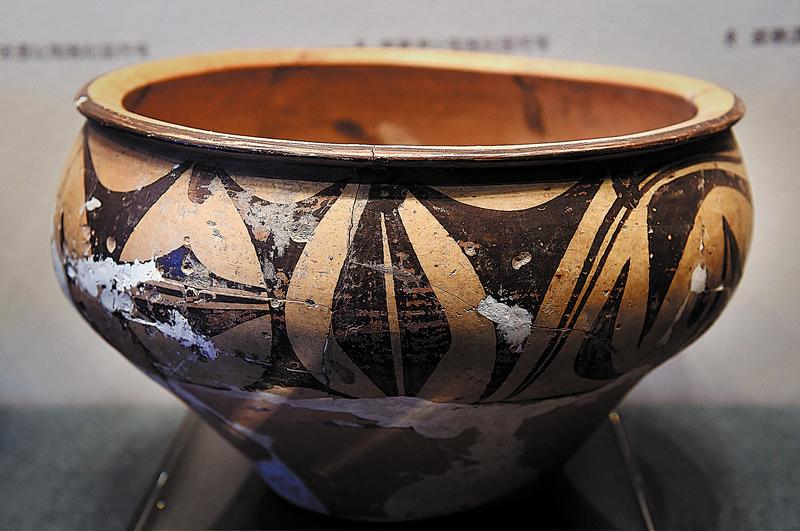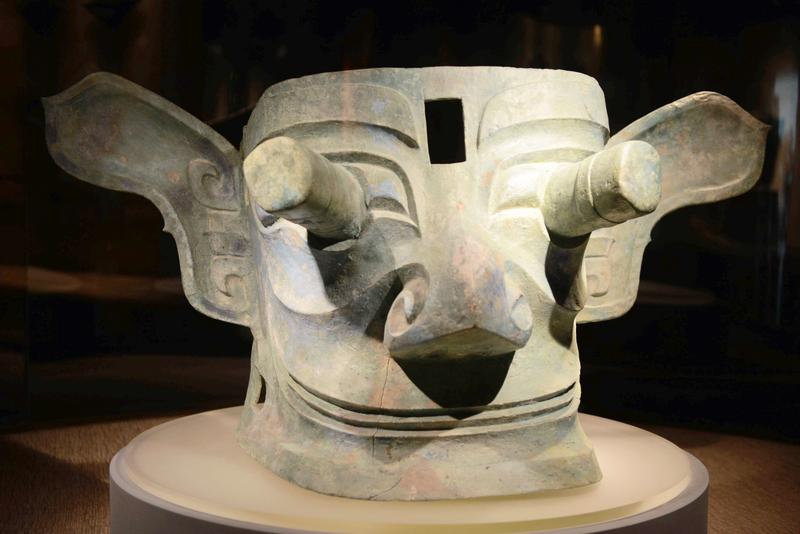 A painted pottery basin is displayed at Yangshao Culture Museum. (LI AN / XINHUA)
A painted pottery basin is displayed at Yangshao Culture Museum. (LI AN / XINHUA)
Generations of Chinese archaeologists have made fruitful findings in the past century, ranging from the discovery of the Yangshao village site in Sanmenxia, Henan province, in 1921, marking the birth of modern Chinese archaeology, to the ongoing excavation of the Sanxingdui site in Sichuan province, which has attracted wide public attention through live broadcasts.
The most significant findings have now been recognized on the list of the top 100 archaeological discoveries of China in the past 100 years.
The past century has told us that Chinese archaeology has to stick to our own characteristics
Wang Wei, president of the Archaeological Society of China
The list was announced by the National Cultural Heritage Administration on Monday at the opening ceremony of the third Chinese Archaeology Congress in Sanmenxia.
In addition to the Yangshao site, which dates back more than 5,000 years and indicates the start of scientific studies of China's Neolithic period, and the Sanxingdui bronze civilization site from about 3,000 years ago, many names familiar to the general public were included on the list.
Among them are the mausoleum of China's first emperor, Qinshihuang, in Shaanxi province, known worldwide as the home of the Terracotta Warriors; the Archaeological Ruins of Liangzhu in Zhejiang province, a UNESCO World Heritage Site where the people of a regional state's capital worshipped jade from 5,300 to 4,300 years ago; and the Zhoukoudian site in Beijing where the famous Peking Man skull fossil was unearthed.
The result was decided from among some 300 candidates after selection rounds co-organized by the National Cultural Heritage Administration, the Archaeological Society of China and the newspaper China Cultural Relics News.
 A jade work is among the findings unearthed from Liangzhu Archaeological Ruins. (JIANG DONG / CHINA DAILY)
A jade work is among the findings unearthed from Liangzhu Archaeological Ruins. (JIANG DONG / CHINA DAILY)
The Neolithic period, which in China is roughly defined as between 10,000 and 4,000 years ago, contributed the most entries to the list, with 33 discoveries from that period included.
Henan leads all provincial-level administrative regions with 14 entries, followed by Shaanxi with 11. The Tung Wan Chai North site in the Hong Kong Special Administrative Region and the Beinan site in Taiwan are also on the list.
Wang Wei, president of the Archaeological Society of China, said these findings demonstrate how the academic achievements of Chinese archaeology have answered questions such as the origins of human beings, agriculture and Chinese civilization, as well as how a united country with multiple ethnic groups formed and developed in China.
"They solved puzzles in their respective fields, and had wide influence at home and abroad," Wang said.
He also sees the list as an answer to President Xi Jinping's call for developing archaeology with Chinese features, style and ethos.
"The past century has told us that Chinese archaeology has to stick to our own characteristics and become rooted in the reality of our country," Wang said. "We cannot just copy experiences and formats of overseas studies."
 A Terracotta Warrior is seen at Emperor Qinshihuang's Mausoleum Site Museum. (PHOTO PROVIDED TO CHINA DAILY)
A Terracotta Warrior is seen at Emperor Qinshihuang's Mausoleum Site Museum. (PHOTO PROVIDED TO CHINA DAILY)
For example, he considers the rich historical documents of ancient China to be crucial references for archaeological studies.
In addition, he said, "We have to maintain frequent communication with foreign scholars and absorb new achievements from international academia. Learning from each other, we can jointly contribute to the general development of the world's archaeology."
More than 700 archaeologists attended the three-day Chinese Archaeology Congress, one of the highest-level academic forums for archaeological studies in China, or joined the conference via video link.
Over 60 archaeologists from about 30 other countries also sent congratulatory messages to the congress, and scholars from nine countries, including the United States, the United Kingdom and India, participated in the conference via video link.
"The last 100 years' archaeological research in China, mostly done by Chinese archaeologists, has really transformed our understanding of a global and human story," said Ian Hodder, a British archaeology professor at Stanford University, in a prerecorded video clip congratulating the congress and the centenary of the birth of modern Chinese archaeology.
"Chinese archaeology is an important contribution to the world's archaeology," he added.
 A bronze mask is displayed at Sanxingdui Museum. (YU FANGPING / FOR CHINA DAILY)
A bronze mask is displayed at Sanxingdui Museum. (YU FANGPING / FOR CHINA DAILY)
The Chinese Archaeology Congress includes 23 professional committees, which are not only based on scholars' expertise in studying different historical periods, but also reflect recent years' interdisciplinary research involving zoology, botany and environmental sciences, among other fields.
Song Xinchao, deputy director of the National Cultural Heritage Administration, said, "When we speak of archaeology with Chinese ethos, we're not talking about how massive our excavations would be or how fruitful the artifacts we'd unearth.
"Following the guidance, we need to comprehensively understand the evolution of Chinese culture through studies of various sites, and thus how they contributed Chinese wisdom to the modern world," Song said.
At the conference, he also vowed that the administration will improve working conditions for archaeologists and cooperate with universities to train more experts for positions where they are urgently needed.



